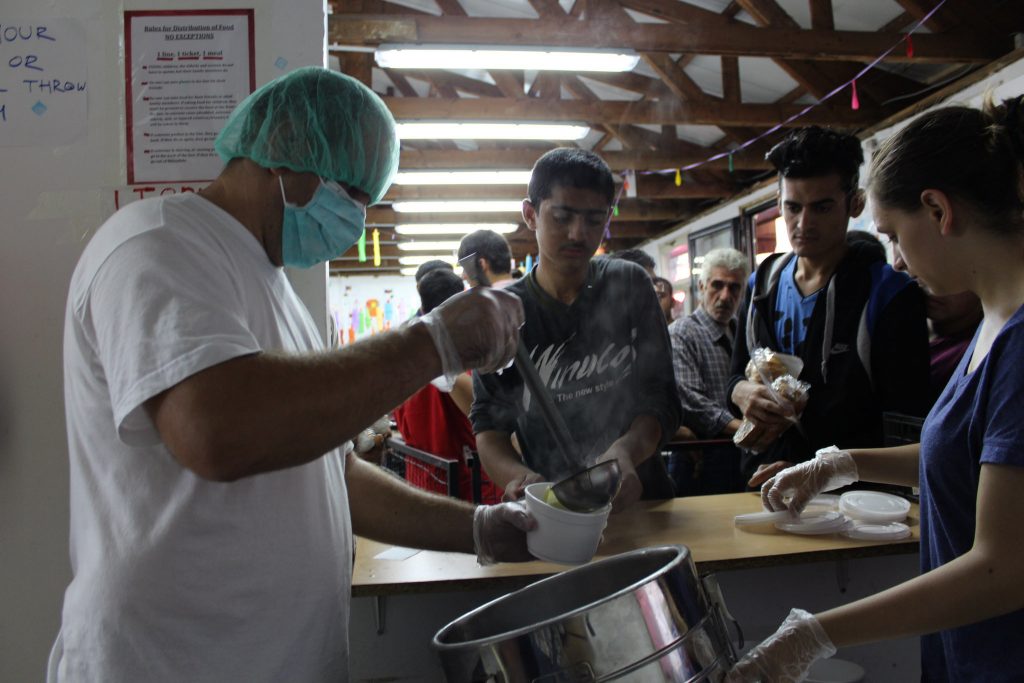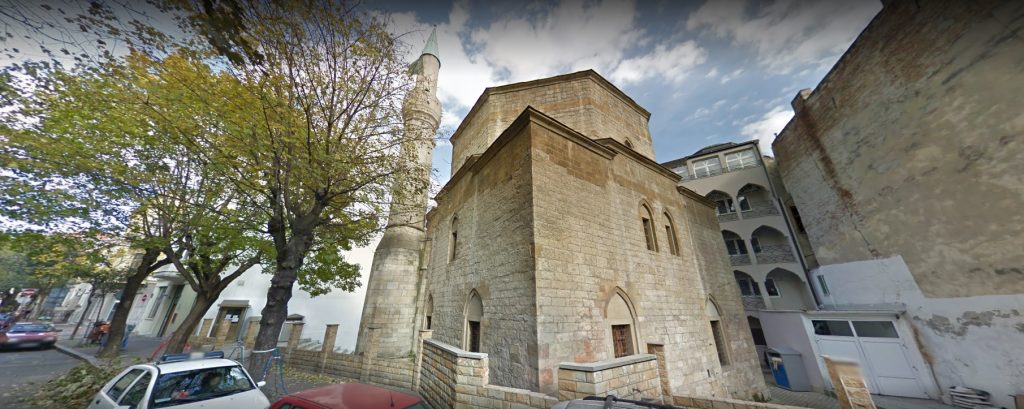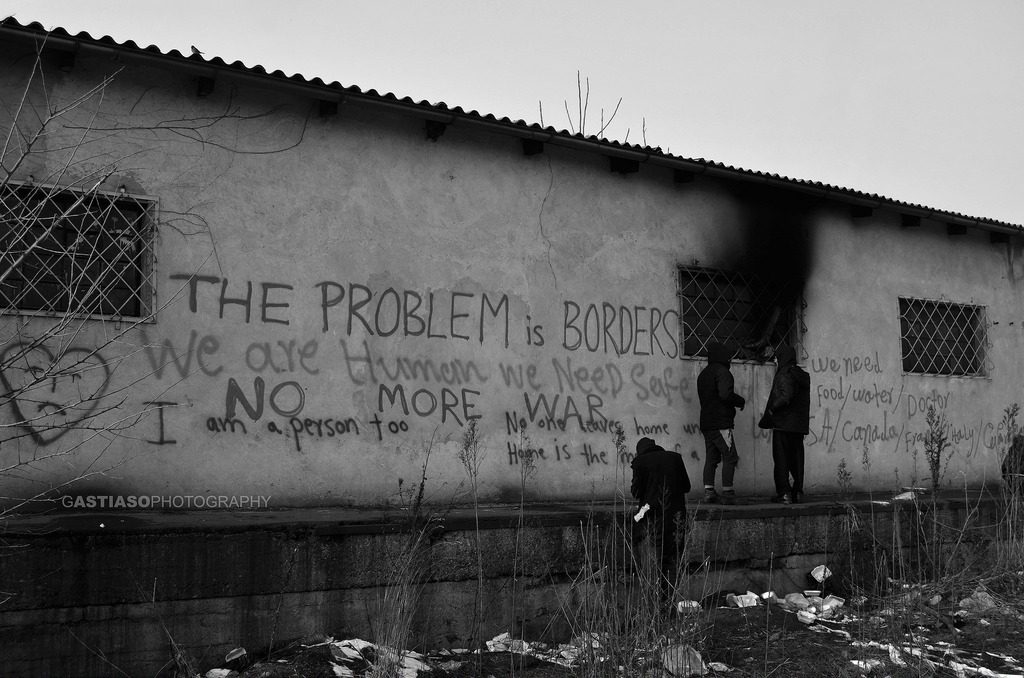Here I was, finally in Belgrade!
Disembarking after a 15-hour bus ride from Berlin, the touts swarmed around me offering taxis and cheap accommodations. Beefy blokes strode by wearing red, blue and white Serbia T-shirts, making a show of their patriotism in this city known for its everyday nationalist display and machismo. I had been to Belgrade a dozen times since 2003, the year Prime Minister Zoran Djindjicwas assassinated by ultra-nationalist thugs, and felt I knew what made this city tick. Belgrade is still poor and struggling along. The cafe and bar scene flourish,but are not entirely new.
New, however, are the refugees.
Over the past year, refugees have flooded Belgrade, particularly around bus and train stations.The crude encampments are one of the first impressions a visitor received after arriving in the city. Thousands of refugees fleeing wars in Syria, Iraq and Afghanistan and heading to EU countries have been waiting in limbo in Belgrade for “agents” — smugglers —to ferry them north through Hungary into Austria and Germany. The refugee crisis has worsened steadily along the Balkan route; at the height of the influx, around 2,000 refugees were entering Serbia every day.
More than a million people have crossed Serbia to EU countries. In first six months of 2015, an estimated 100,000 refugees crossed Serbia on the same path. Yet only a handful have requested asylum in Serbia, a country with its own economic woes (unemployment stands at almost 20%) and a history of immigration to the West (40,000 Serbs emigrate every year).
Making my way through Park Luke Ćelovića to the center of Belgrade, I passed pockets of refugees smoking cigarettes and conferring with one another about the next stage of their journeys. Meals were being served and Doctors Without Borders was operating out of a truck in a corner of the park. It seemed the authorities were at the end of their tether, and measures were being taken to make the refugees feel uncomfortable and unwelcome. The park and the adjoining Bristol Park had been plowed up and orange plastic fences erected to prevent refugees from sleeping there in the rough. Patrols were cruising the parks and areas where refugees gathered or slept, urging them to embark on shuttle buses to the border.

Soup being distributed to refugees in Belgrade. Flickr/Trocaire
There were refugees of all sorts —families, small children, single men —using every available space, roofed place or park bench to settle down for a brief respite. In the absence of public toilets, refugees built improvised showers and toilets using the rubble of damaged buildings or abandoned spaces. This was Belgrade, September 2016.
The refugee influx from the Middle East was challenging the citizens of Belgrade. Not only was it putting strains on the city’s already woefully inadequate infrastructure, but there was also the cultural dimension to consider. Belgrade is a fairly homogeneous city —if one discounts the large Roma minority —with most inhabitants Orthodox Christians and with little experience of immigration from outside Europe. During the Balkan wars of the 1990s, Belgrade was the headquarters of a rabidly xenophobic propaganda machine that vilified Muslims, Croats and Albanians, and nationalist graffiti on house fronts attest to still simmering feelings of hate and chauvinism toward other ex-Yugoslav ethnicities. So how were the Serbs of Belgrade coming to terms with these mostly Muslim refugees from Syria, Iraq and Afghanistan?
There were 228,658 Muslims in Serbia (excluding the disputed region of Kosovo, this comes out to 3.1% of the total population), according to the 2011 census. Most are in the municipalities of Novi Pazar, Tutin and Sjenica in the Sandžak region of south Serbia, bordering Kosovo, Montenegro and Bosnia. These Muslims are self-described Bosniaks, while Christian Serbs regard them as Muslim Serbs —renegades from the true faith. There are also Muslims from Albanian pockets in south Serbia and Kosovo. There are 20,000 Muslims estimated to be living in Belgrade.
An Ottoman History
The Serbs have a deeply rooted nationality complex stemming from centuries of Ottoman Turkish occupation. In 1456, Sultan Mehmet II stormed up the Danube with his battle-hardened army of veterans, heroes of Constantinople and Sofia. His objective was the key to all Central Europe, a city the Ottomans named Dar-ne-jihad(Battlefield of Holy War) and known to us as Belgrade, the White City. The army was repelled and Belgrade didn’t fall to the Turks until 1521. Under nearly 300 years of Turkish occupation, Belgrade languished under the green flag as an Ottoman pashalik.
Belgrade was the last bastion of Turkey in Europe: warlike, soldierly and caparisoned with a stern and ferocious air about it. Whenever the Ottoman army approached from the southeast, at least every other year, officers arrived in advance to shut up the wine shops. The soldiery gathered in Zeman, the other side of the Sava. Armies coming from Anatolia met armies coming up the Danube and the forces mustered by the Ottoman Empire. Civilians were called to attention on the street and many earned their livelihood from serving the army, sewing, mailing and butchering. Belgrade had a through-and-through martial demeanor.
Shadows of the Old East
To this day, Belgrade —in its food, music, architecture, shapelessness and confusion, language and mentality of its inhabitants — bears traces of its former Turkish domination.Accordion-accompanied folk music with wailing, melismatic vocals wafts from radios. The Serbs like to portray their country as a bulwark of Western culture against the East and the Turks, muttering about subjection to the Ottomans and proud of holding out against the Muslim tide. Yet for centuries, they wore half-Turkish dress, furnished their houses in Turkish fashion, (still) sprinkled their language with Turkish words (“sat”: time, “para”: money, “budala”: fool…), danced in Eastern style. An observer wrote in 1903: “Strangers find great difficulty in distinguishing between Christians [Serbs] and the Turks [Slav Muslims] in Bosnia, for both wear turbans, embroidered waistcoats, loose open jackets, zouave trousers gathered at the knee, and heel-less shoes with toes that turn up.” And today, Turkey is still a preferred summer holiday destination for Serbs.
Serbs have a complex about their Eastern influence and Muslim neighbors, which is from time to time instrumentalized and stoked up by politicians and media
Listening to Serbian songs today, I can’t help but feel that their music wouldn’t have been out of place in a kebap house in Istanbul. In fact, during the days of the Crusades, the melodies of the Serbian Church were brought from Syria, introduced to the Balkans along pilgrim routes that bypassed Constantinople. It was another kind of music that greeted your ears in Serbia and it didn’t tally at all with anything that I expected:You hear it and realize you are no longer in “Europe.”
And yet Serbs have a complex about their Eastern influence and Muslim neighbors, which is from time to time instrumentalized and stoked up by politicians and media. Theirs is the anxiety of a small, besieged nation afraid of disappearing. Many hold to conspiracy theories, maintaining that the West is bent on eliminating Serbia, that the world hates Serbia, that the Bosnian Muslims were the aggressors in the war between 1992 and 1995, and the Muslims committed genocide against the Serbs.
In 1997, the Serbian Patriarch Pavle signed a “Declaration against the Genocide of the Serbian People,” which defined the Serbs not only as self-defenders but also as defenders of Europe: “Since the early Middle Ages, the Serbs, together with their rulers and church dignitaries fighting the Turks, have been the last rampart in the defense of Europe from the Turkish invasion and the penetration of Islam.”
Surviving Ottoman Structures
At the height of the Ottoman period, there were 273 mosques in Belgrade. Most of them were destroyed, but not by the Serbs, it must be said. The Austrian army led by Eugene of Savoy (1663-1736) razed Belgrade in 1717.
Only a couple of structures dating from the Ottoman period survive in Belgrade today, a city which despite its great age going back to the Celts and Avars, retains few structures of antiquity owing to the fact that it was razed some 40 times.
One structure is Damad Ali Pasha’s turbe, an octagonal mausoleum at Belgrade Fortress where Grand Vizier Damad Ali Pasha — who was fatally wounded while battling Austrians at Petrovaradin fortress in 1716 — is buried. Another is the turbe of Sheikh Mustafa near Studenski Park on Visnjiceva Street. It was built in the middle of a tekke (Sufi lodge) in 1784. Sheikh Mustafa, a dervish, was buried in the turbe, but the tekke is long gone.
Bajrakli Mosque is the only mosque in Belgrade today that is still active, serving 2,000 Muslims
“We have these two turbes and both are still remaining and looked after by the Serbs because those two pashas were really beloved by the Serbs,” says Milan Đurić, a Belgrade ethnologist and musician. “Because they were nice to the Serbs. One of them was called ‘Serbian mother’ because he gave us rights. … The relationships between the Serbs and Turks has had its ups and downs, like everything. Those turbes are relics of the good times.”
As far as mosques go, from the hundreds of mosques that once graced the Belgrade skyline, only one mosque still exists: Bajrakli džamija, situated in the oldest part of Belgrade, which is to this day known by the Turkish name Dorcol. The mosque is on Gospodar Jevremova Street. It’s named after the Turkish word for flag (bayrak),which signaled the call to prayer for mosques all around. Out of the endowment of Sultan Suleiman II and Čohadži-Hajji Alija, a cloth merchant, the mosque was built between 1660 and 1688.The single-spaced building with a dome and minaret has been demolished or its function has changed a number of times over the centuries. When the Austrians occupied Serbia in the 18th century, the mosque was converted into a Roman Catholic church, but after the Ottomans retook Belgrade, it was returned to its original function. In 1741, Hussein Bey, assistant to Turkish chief commander Ali Pasha, renewed the building and it was renamed after him. At the end of the 18th century,the name was changed once more, to Bajrakli Mosque, and is the only Muslim mosque in Belgrade today that is still active, serving 2,000 Muslims — Bosnians, Muslim Serbs from the Sandžak, Albanians, Macedonians and lately, refugees from Syria, Iraq and Afghanistan.Many refugees came to Bajrakli Mosque to find help, food, clothes, shoes and medicaments.

Bajrakli Mosque in Belgrade. Via Google Maps
The interior is very modest. The walls are without plaster, and are decorated with shallow moldings, stylized floral and geometrical motifs and calligraphic inscriptions of verses from the Quran, the names of the caliphs, and Allah’s magnificent properties and names written in Arabic letters on carved wooden panels. There is an arched arcade porch with three small domes at the entrance, a fountain for ritual ablution in the courtyard and a medresa with a library.
It was in the courtyard that I got in a conversation with Muedib, a tall Bosniak who heads the administration of the mosque.I ask Muedib if the mosque issued the ezan— the call to prayer – from the minaret. Muedib says that it does not, out of fear.
In March 2004, Islamophobia came to a head after news spread that Albanians in Kosovo were destroying Orthodox churches, which itself followed news (spurious, as it turned out) that Serbs had drowned a couple of Albanian youths. Angry Serb mobs set fire to the mosque, medresa and library, with 7,000 books destroyed. Milan Obradović, the city’s police chief, was sacked in the aftermath, but he accused Interior Minister Dragan Jočić of giving him “a direct order not to use force against protesters.”
I asked Muedib if it was difficult being a Muslim in Belgrade.
“In the one hand, yes. In second hand, no,” says Muedib. “It’s okay. It’s peaceful environment. Belgrade is multi-religious and multi-nationality city. It is capital of Serbia, and the citizens are so peaceful. Now it’s okay. But you see, we have a policeman 24 hours.
“Five hundred people come to the mosque for Friday prayers. Mosque is full. And we have one mescid on the fourth floor. Now we have a lot of believers from Bosnia, Serbia, Arab countries, Turkish man, Kosovo, Macedonian.”
Muedib said the Muslim community has been distributing food and clothing to refugees sleeping in Belgrade’s parks.

The border near Belgrade. Flickr/G.Astiaso
“Some people came here when it was raining,” Muedib said. “I can’t tell the exact number, but there were not many people here. They came when it was cold and rainy, for warmth and shelter.”
In Sarajevo two years ago, I had spoken to a Bosnian imam who told me of cases of Serbs — usually staunchly Orthodox Christian —who became Muslim. I asked Muedib if he knew of such cases in Belgrade.
“Yes, we have,” he said. “But it’s not every day, every month. But we have, maybe two, three, four times in one year persons who converted from Orthodox faith to Islam. But that situation is very difficult because that guy who converted to Islam is not good Orthodox believer. He is maybe atheist or agnostic. And that is when he finds some answers in Islam. And converted to Islam. That is it.”
Wayfaring Strangers
Inside the Bajrakli Mosque, I also spoke with Fahim and Awlia, two Afghani refugees who had an amazing footsore journey behind them, having walked from Turkey, through Bulgaria to Serbia and were now sleeping in a parking lot off Park Luke Ćelovića. They liked the Serbs, I was surprised to hear, found them friendly and welcoming. The Bulgarians, on the other hand, had hassled them, hurled racist abuse and spat at them. Sure there were Serbs who stood up and changed seats when the refugees sat next to them on the trams, but they were still better than the Bulgarians.
Awlia showed me his perforated jeans, ripped by the dogs. His friends were still in the hospital recuperating from their wounds
Fahim was a boxer with iron biceps and a hafiz, who had committed the entire Quran to memory. He had family in Afghanistan, including a son who was being trained to be a hafiz like his father. Fahim’s father had given him €2,000, which he was going to give to an “agent” to bring him across Hungary into Germany, his ultimate destination.
His traveling partner, Awlia, had already attempted a foray through Hungary with another group, and had been halted by police, who had set their German shepherds on them. Awlia showed me his perforated jeans, ripped by the dogs. His friends were still in the hospital recuperating from their wounds.
After prayer, I walked up over the top of Belgrade with Fahim and Awlia, past the packed cafes on Knez Mihailova, where we made jokes about the fun-loving Serbs, who, despite the dire economy and unemployment, continued to live it up in the bars and cafes of Belgrade.
I asked them what they would do when the cold set in and they still hadn’t made it to Germany. Fahim said they hoped to be gone by then.We walked down past Belgrade market to Park Luke Ćelovića, so Fahim and Awlia could show me where they lived.The cops had dug up the grass and fenced it off to keep the refugees from sleeping there. The police urged them to move on to Hungary.
“Make dua for us,”said Fahim upon parting ways. “Pray for us.”
Surprising Hospitality
It surprised me to learn from the Afghani refugees about the Serbs’ hospitality toward them. But maybe it shouldn’t have.
“You know, Serbia is one of the countries with the largest number of refugees in the world,” Milan Đurić said. “Most of those refugees are Serbs and [Roma] from the other republics of Yugoslavia. So I think they will at least feel kind of sympathetic toward them. Because the Serbs remember how it was to be a refugee. I think that maybe that’s why it’s not so negative.”
*Image: The border of Belgrade. Flickr/G.Astiaso





